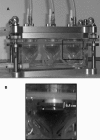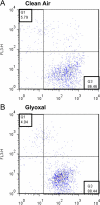Evaluation of dicarbonyls generated in a simulated indoor air environment using an in vitro exposure system
- PMID: 20200221
- PMCID: PMC2902857
- DOI: 10.1093/toxsci/kfq067
Evaluation of dicarbonyls generated in a simulated indoor air environment using an in vitro exposure system
Abstract
Over the last two decades, there has been increasing awareness regarding the potential impact of indoor air pollution on health. Exposure to volatile organic compounds (VOCs) or oxygenated organic compounds formed from indoor chemistry has been suggested to contribute to adverse health effects. These studies use an in vitro monitoring system called VitroCell, to assess chemicals found in the indoor air environment. The structurally similar dicarbonyls diacetyl, 4-oxopentanal (4-OPA), glyoxal, glutaraldehyde, and methyl glyoxal were selected for use in this system. The VitroCell module was used to determine whether these dicarbonyls were capable of inducing inflammatory cytokine expression by exposed pulmonary epithelial cells (A549). Increases in the relative fold change in messenger RNA expression of the inflammatory mediators, interleukin (IL)-6, IL-8, granulocyte-macrophage colony-stimulating factor (GM-CSF), and tumor necrosis factor alpha (TNF-alpha) were identified following exposure to diacetyl, 4-OPA, glyoxal, glutaraldehyde, and methyl glyoxal when compared to a clean air control. Consistent results were observed when the protein levels of these cytokines were analyzed. Exposure to 4-OPA significantly elevated IL-8, IL-6, GM-CSF, and TNF-alpha while glutaraldehyde caused significant elevations in IL-6, IL-8, and TNF-alpha. IL-6 and IL-8 were also significantly elevated after exposure to diacetyl, glyoxal, and methyl glyoxal. These studies suggest that exposure to structurally similar oxygenated reaction products may be contributing to some of the health effects associated with indoor environments and may provide an in vitro method for identification and characterization of these potential hazards.
Figures









References
-
- Anderson SE, Wells JR, Fedorowicz A, Butterworth LF, Meade BJ, Munson AE. Evaluation of the contact and respiratory sensitization potential of volatile organic compounds generated by simulated indoor air chemistry. Toxicol. Sci. 2007;97:355–363. - PubMed
-
- Aschmann SM, Tuazon EC, Arey J, Atkinson R. Products of the gas-phase reaction of O-3 with cyclohexene. J. Phys. Chem. 2003;107:2247–2255.
-
- Azadi S, Klink KJ, Meade BJ. Divergent immunological responses following glutaraldehyde exposure. Toxicol. Appl. Pharmacol. 2004;197:1–8. - PubMed
-
- Bakand S, Winder C, Khalil C, Hayes A. A novel in vitro exposure technique for toxicity testing of selected volatile organic compounds. J. Environ. Monit. 2006;8:100–105. - PubMed
-
- Bautista MV, Chen Y, Ivanova VS, Rahimi MK, Watson AM, Rose MC. IL-8 regulates mucin gene expression at the posttranscriptional level in lung epithelial cells. J. Immunol. 2009;183:2159–2166. - PubMed
Publication types
MeSH terms
Substances
Grants and funding
LinkOut - more resources
Full Text Sources
Medical

